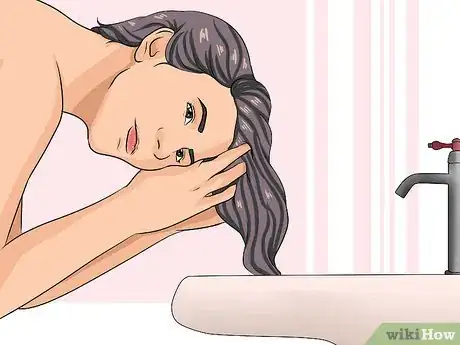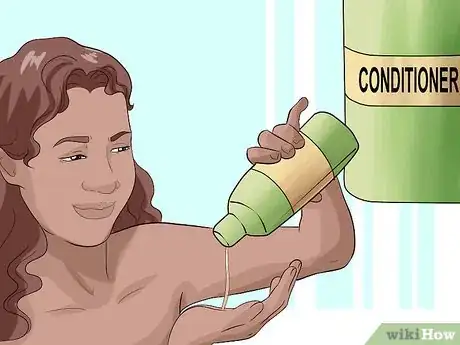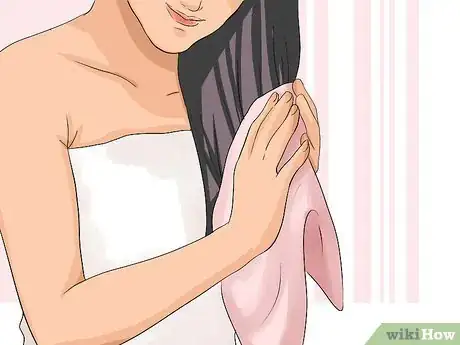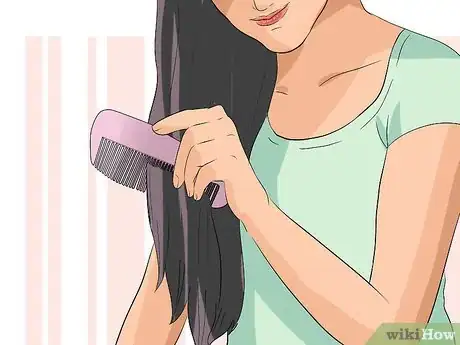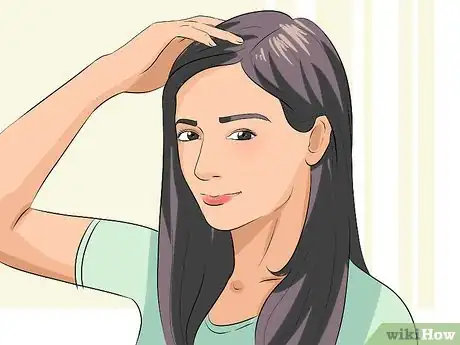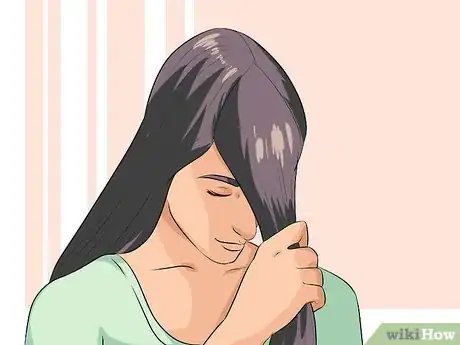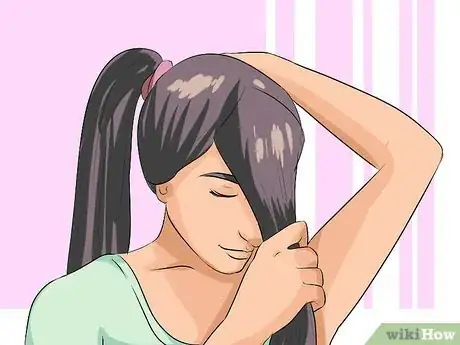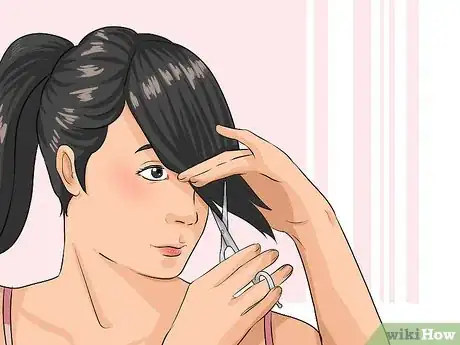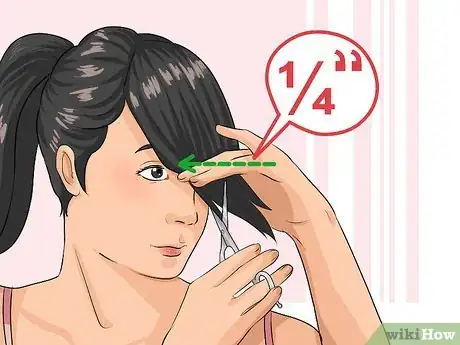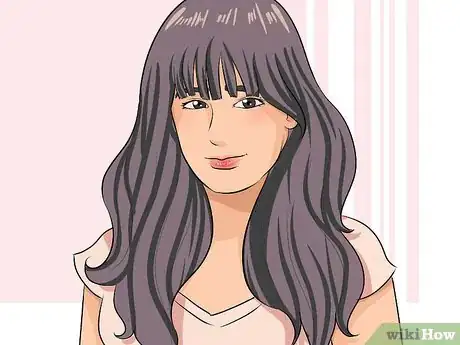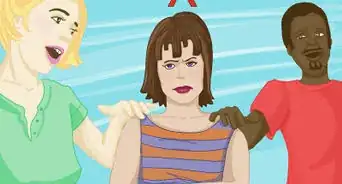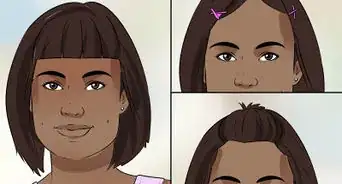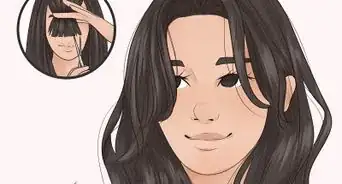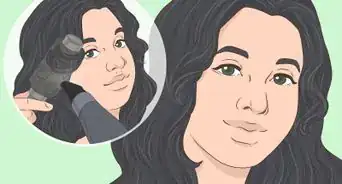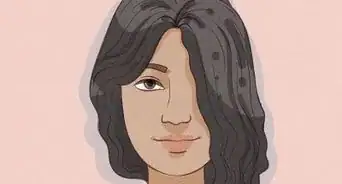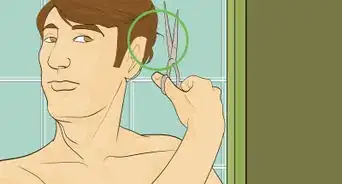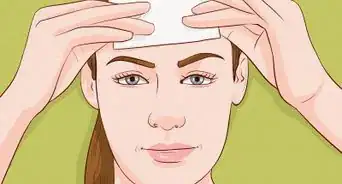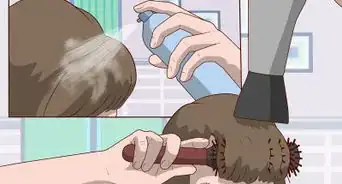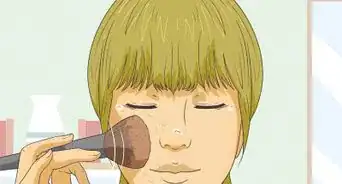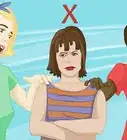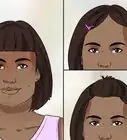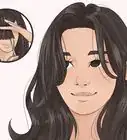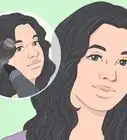This article was co-authored by Courtney Foster. Courtney Foster is a Licensed Cosmetologist, Certified Hair Loss Practitioner, and Cosmetology Educator based out of New York City. Courtney runs Courtney Foster Beauty, LLC and her work has been featured on The Wendy Williams Show, Good Morning America, The Today Show, The Late Show with David Letterman, and in East/West Magazine. She received her Cosmetology License from the State of New York after training at the Empire Beauty School - Manhattan.
This article has been viewed 300,990 times.
Bangs, or what many refer to as a "fringe," are a great way to change or spice up your look. The hairstyle entails shorter hair set in front of your existing hair, framing the face with a fashionable flair. The style has been utilized by such fashion icons as Bettie Page, Elizabeth Taylor and even The Beatles. Today, celebrities like Emma Stone and Rihanna can be seen flaunting the look with confidence. What most people don't know is you can have this popular hairstyle without leaving your own home.
Steps
Preparing Your Hair
-
1Cleanse your hair. Wash your hair thoroughly with shampoo in a shower or sink – for best results, try a high-quality one designed for your hair type. Make sure your hair is thoroughly rinsed of shampoo before proceeding.
- Cutting your hair while it's dirty is not what stylists consider ideal. Unwashed hair has a good chance of containing patches of grease or product build-up, which can lead shears to slip and cut unevenly.
-
2Condition your hair, if needed. Most people don’t need to condition the bang area. But for those who do, conditioner will help relax your hair and make it much easier to deal with in cutting. Conditioner leaves a bit of moisture in the hair, allowing it to fall agreeably and become easier to manage.[1]
- Be sure to keep the conditioner at least 1 inch away from your scalp to avoid flat, greasy bangs.
Advertisement -
3Dry your hair. Dry your hair by taking sections and squeezing them gently with a towel, working from the roots to the ends before moving to a new section. A microfiber towel works best for this.
- You can also use a blow-dryer for faster results, but be aware that heat causes changes in the hydrogen bonds that hold hair together. Too much heat can result in permanent damage.[2]
- Don’t fret if your hair’s not completely dry. Actually, this might be better. Cutting completely dry hair gives you an immediate sense of the results but is hard to do and needs sharp tools. You may find it uneven when washed and restyled.
- Cutting your hair while damp is easier – not dripping wet, just towel dried to even dampness. It’s more likely to give an even result. Your hair shouldn’t clump together or drip.
-
4Comb your hair. Combing your hair will allow you to find an ideal length and measurement. The combing process will also detangle any hairs that have bunched up in the drying process.
- To get rid of tangles and knots with the least amount of hair damage, use a wide-tooth comb, start at the ends of your hair, and work your way up toward your roots. [3]
-
5Part your hair, or not. There are un-parted as well as parted bang styles. If you’re going for a long-side swept bang or a parted bang, you can part your hair where you normally wear it before cutting. Otherwise, let it hang down un-parted.
- Bangs are essentially a shorter version of your current hairstyle, but help frame your face. Wearing it as normal will help you get a better idea of how you would like it cut.
-
6Section off the hair that you intend to be your bangs. Section off the triangle of hair from the top-center of your head to the outsides of your eyebrows. It shouldn’t extend past the outer corners of your brows or the top of your head.[4]
- Use a uniform triangular shape when you section the hair. For thicker bangs, start further back on your head. For less thickness, start closer to your forehead.
- If your hair is layered, grab the strands of hair that are used to blend the front portion of your hair to the back portion. These hairs are often shorter and easier to transform into bangs due to their short length.
-
7Put the rest of your hair in a ponytail. Having hair out of the way can give you a better sense of how the bangs will look.
- Working without hair potentially getting in the way can help you avoid mistakes and cutting unintended hair. A ponytail is also another look you may want to incorporate with your new style.
-
8Comb out the section of your hair evenly in front of your face. Combing the hair out in front of your face will help you see when you are cutting as well as how short you will have to cut in order to see.
- Don't be afraid to pull hair from further back and near the center of your head. This can often help avoid issues of thinness when your bangs are ready to be styled.
Cutting Your Hair
-
1Choose an appropriate pair of scissors. Styling scissors can be bought at any beauty supply store. The scissors have a sharpness meant for hair. Common household scissors are meant to cut more coarse things like paper and plastic.[5]
- Beauty supply stores often sell scissors meant for hair at various sizes. Smaller scissors will allow for more control and may come in handy when shaping your fringe.
-
2Divide the bangs into 1” sections and start cutting at the bottom section. Divide your hair into horizontal rows of no more than 1” thick. Then, begin at the bottom. Hold the scissors upright and line them up along your hair before cutting. Make minimal, vertical snips at your bangs that go along the hair rather than across. This will help avoid cutting your hair into a flat line.
- For classic bangs, the shortest point should fall at the bridge of the nose between your eyes. Remember to cut less and leave more. You can always come back and cut more if your new bangs are too long.
- You can keep your hair in position with a comb with your non-dominant hand and cut with your dominant hand.
-
3Move your scissors to the left or right about a quarter of an inch, and continue cutting. Move as little to one side as possible to ensure you're cutting all of your intended bangs. Continue making vertical snips along your hairs' ends. Cut as flat as possible - without cutting across - near the middle of your head and allow for longer strands as you work your way outward. After you've finished one side, repeat the process on the other.
- Cut at a diagonal angle - about 45 degrees - to achieve an edgier, less blunt look.
- Some bangs are straight across the forehead and longer as you get to one side. Other styles can be curved, with length that slightly increases toward the outside corners.
-
4Repeat the cutting process until you manage to shape your new bangs. Keep working your way up toward the crown of your head, cutting as sparingly as possible and never directly across. When your bangs are there, you'll know it!
- Cutting less and leaving more hair is a great way to avoid common mistakes like a crooked line or missing chunks.
- Remember to be patient. Think of your hair as an art piece - nothing is perfect when rushed.
-
5Shake your hair around, part it, and you're done! Congratulations, you've achieved one of the most popular and fashionable hairstyles out there, all from the comfort of your own home!
- Remember, if your bangs are still too long, you can always re-comb and re-cut. The same cannot be said about them being too short!
- If your new bangs are too thin, pull hair from closer to the top of your head and cut accordingly. If they’re too thick, hold them up straight and cut into the ends deeply with vertical or diagonal snips.
Expert Q&A
Did you know you can get expert answers for this article?
Unlock expert answers by supporting wikiHow
-
QuestionDo I need to cut split ends in my bangs?
 Courtney FosterCourtney Foster is a Licensed Cosmetologist, Certified Hair Loss Practitioner, and Cosmetology Educator based out of New York City. Courtney runs Courtney Foster Beauty, LLC and her work has been featured on The Wendy Williams Show, Good Morning America, The Today Show, The Late Show with David Letterman, and in East/West Magazine. She received her Cosmetology License from the State of New York after training at the Empire Beauty School - Manhattan.
Courtney FosterCourtney Foster is a Licensed Cosmetologist, Certified Hair Loss Practitioner, and Cosmetology Educator based out of New York City. Courtney runs Courtney Foster Beauty, LLC and her work has been featured on The Wendy Williams Show, Good Morning America, The Today Show, The Late Show with David Letterman, and in East/West Magazine. She received her Cosmetology License from the State of New York after training at the Empire Beauty School - Manhattan.
Licensed Cosmetologist You can, but it's more important to cut split ends the longer your hair is, and bangs don't typically get very long. If you have too many split ends, the split ends will travel up the hair shaft and lead to breakage. So if you don't cut the split ends out, your hair will eventually need to be cut back much shorter than you normally do.
You can, but it's more important to cut split ends the longer your hair is, and bangs don't typically get very long. If you have too many split ends, the split ends will travel up the hair shaft and lead to breakage. So if you don't cut the split ends out, your hair will eventually need to be cut back much shorter than you normally do. -
QuestionMy bangs are too thick. What should I do?
 Laura MartinLaura Martin is a Licensed Cosmetologist in Georgia. She has been a hair stylist since 2007 and a cosmetology teacher since 2013.
Laura MartinLaura Martin is a Licensed Cosmetologist in Georgia. She has been a hair stylist since 2007 and a cosmetology teacher since 2013.
Licensed Cosmetologist
-
QuestionHow do I curl the ends of my bangs under?
 Laura MartinLaura Martin is a Licensed Cosmetologist in Georgia. She has been a hair stylist since 2007 and a cosmetology teacher since 2013.
Laura MartinLaura Martin is a Licensed Cosmetologist in Georgia. She has been a hair stylist since 2007 and a cosmetology teacher since 2013.
Licensed Cosmetologist
Warnings
- Make sure it is the style you want. Otherwise you will be stuck with bangs that are too short or are not the style you wanted.⧼thumbs_response⧽
References
- ↑ Courtney Foster. Professional Hair Stylist. Expert Interview. 9 December 2019.
- ↑ Courtney Foster. Professional Hair Stylist. Expert Interview. 9 December 2019.
- ↑ http://www.thehairstyler.com/features/articles/hair-care/hairstyling-tools-brush-vs-comb
- ↑ https://www.brit.co/diy-bangs/
- ↑ Courtney Foster. Professional Hair Stylist. Expert Interview. 9 December 2019.
About This Article
Before you cut your hair into fringe bangs, section off the triangle of hair from the top-center of your head to the outsides of your eyebrows. Then, comb the hair out flat in front of your face. Next, divide your hair into 1 inch sections, and cut in vertical snips from the bottom. If you want classic bangs, aim for the shortest point to fall at the bridge of your nose. As you cut, move your scissors no more than 1/4 inch at a time so you don't miss any hair. Additionally, always try to cut as sparingly as possible and never directly across. For tips on how to wash and prepare your hair before cutting it, keep reading!
